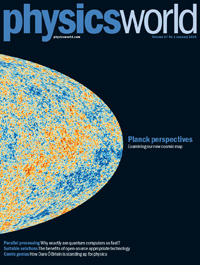By Matin Durrani

Happy new year and welcome back to Physics World!
If you’re a member of the Institute of Physics (IOP), it’s time to get stuck into the new issue of Physics World, which you can access free via the digital version of the magazine or by downloading the Physics World app onto your iPhone or iPad or Android device, available from the App Store and Google Play, respectively.
In this month’s cover feature, Peter Coles from the University of Sussex in the UK examines the implications of the data of the cosmic microwave background obtained by Europe’s Planck satellite.
There’s also a great article by science journalist Philip Ball, who looks at exactly why quantum computers are so fast – the speed is often put down to many calculations operating in parallel, but some theorists are not so sure. Meanwhile, Joshua Pearce from Michigan Technological University explains how physicists can contribute to open-source “appropriate technology” – devices that can be easily and cheaply built usiing materials and techniques available to people in developing nations.
Remember that if you’re not yet a member, you can join the Institute as an IOPimember for just £15, €20 or $25 a year. Being an IOPimember gives you a full year’s access to Physics World both online and through the apps.
For the record, here’s a run-down of highlights in the issue.
• CERN gears up for new experiments – CERN’s Large Hadron Collider is not due to switch back on until 2015, but several new experiments at the lab, including NA62, will start up this year. Hamish Johnston reports
• Keeping serendipity alive – As lead editor of Physical Review Letters, Pierre Meystre from the University of Arizona at Tucson discusses the challenges facing one of the most influential physics journals
• Moving the goalposts – A new book about string theory offers a surprising way to explain philosophy of science, says Robert P Crease
• Harming physics business – Immigration policies in the UK are making it increasingly difficult for hi-tech physics companies to do business, warns Jeremy Good
• Planck perspectives – The Planck mission has produced a map of the cosmic microwave background at higher resolution than ever before. Peter Coles explains its implications for our understanding of the universe
• Questioning quantum speed – The promised speed of a quantum computer is usually explained in terms of its ability to make many calculations in parallel. But, as Philip Ball reports, many quantum theorists reject this idea and point to other explanations entirely
• Technology whose time has come – Joshua Pearce describes how physicists can help bring simple, affordable and life-changing devices to people and laboratories all over the world, using the concept of open-source appropriate technology
• Mathematics and prejudice – William Gasarch reviews Love and Math: the Heart of
Hidden Reality by Edward Frenkel
• Rise and fall of an electrical genius – David Goodstein reviews Tesla: Inventor of the Electrical Age by W Bernard Carlson
• From astronauts to cancer patients – A career in radiation physics offers plenty of variety and the chance to solve problems that directly affect patient care, as Lindsay Beaton-Green explains
• Once a physicist – This month we talk to Dara Ó Briain, physicist turned comedian
• Lateral Thoughts: A short history of radar in Norwegian – Clive Alabaster draws parallels between learning a new language and signal communication
Enjoy the issue – and let me know what you think by e-mailing me at pwld@iop.org.
Guidelines
Show/hide formatting guidelines
this text was deletedwhere people live in harmony with nature and animals</q>
Some text